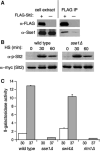The Hsp110 protein chaperone Sse1 is required for yeast cell wall integrity and morphogenesis
- PMID: 18478233
- PMCID: PMC5635425
- DOI: 10.1007/s00294-008-0193-y
The Hsp110 protein chaperone Sse1 is required for yeast cell wall integrity and morphogenesis
Abstract
Molecular chaperones direct refolding and triage decisions and support signal transduction responses to cytotoxic stress. The eukaryotic chaperone Hsp110 is represented by the SSE1/2 genes in Saccharomyces cerevisiae, which act as nucleotide exchange factors (NEFs) for cognate cytosolic Hsp70 chaperones. In this report, we present evidence that Sse1 is required for signaling through the cell integrity pathway via partnership with Hsp90 and the terminal MAP kinase Slt2. We found that sse1Delta and sti1Delta mutant cells share the typical cell integrity mutant phenotypes of osmoremediated temperature-sensitive growth and sensitivity to cell wall-damaging agents. Sse1 binds to Slt2 in vivo and similar to Hsp90 mutants, Slt2 stability and phosphorylation is not compromised in sse1Delta cells, whereas activation of the downstream transcription factor Rlm1 is abolished. In addition to Rlm1, Slt2 activates the Swi4/Swi6 heterodimer SBF in response to cell wall damage. SSE1 displayed dramatic synthetic phenotypes when disrupted in combination with mutations in SBF and the related Mbp1/Swi6 heterodimer MBF, characterized by severe growth and morphological defects. These defects were reversed by restoration of Hsp70 NEF activity, providing a mechanistic model wherein Sse1 functionally partners with Hsp90 as an Hsp70 NEF to promote client protein maturation and interaction with downstream effectors.
Figures






Similar articles
-
Hsp110 chaperones control client fate determination in the hsp70-Hsp90 chaperone system.Mol Biol Cell. 2010 May 1;21(9):1439-48. doi: 10.1091/mbc.e09-09-0779. Epub 2010 Mar 17. Mol Biol Cell. 2010. PMID: 20237159 Free PMC article.
-
Substrate binding by the yeast Hsp110 nucleotide exchange factor and molecular chaperone Sse1 is not obligate for its biological activities.Mol Biol Cell. 2017 Jul 15;28(15):2066-2075. doi: 10.1091/mbc.E17-01-0070. Epub 2017 May 24. Mol Biol Cell. 2017. PMID: 28539411 Free PMC article.
-
The yeast Hsp110 Sse1 functionally interacts with the Hsp70 chaperones Ssa and Ssb.J Biol Chem. 2005 Dec 16;280(50):41262-9. doi: 10.1074/jbc.M503614200. Epub 2005 Oct 12. J Biol Chem. 2005. PMID: 16221677
-
The control of spindle length by Hsp70 and Hsp110 molecular chaperones.FEBS Lett. 2013 Apr 17;587(8):1067-72. doi: 10.1016/j.febslet.2013.02.018. Epub 2013 Feb 19. FEBS Lett. 2013. PMID: 23434584 Review.
-
Hsf1 on a leash - controlling the heat shock response by chaperone titration.Exp Cell Res. 2020 Nov 1;396(1):112246. doi: 10.1016/j.yexcr.2020.112246. Epub 2020 Aug 27. Exp Cell Res. 2020. PMID: 32861670 Review.
Cited by
-
Rapid deacetylation of yeast Hsp70 mediates the cellular response to heat stress.Sci Rep. 2019 Nov 7;9(1):16260. doi: 10.1038/s41598-019-52545-3. Sci Rep. 2019. PMID: 31700027 Free PMC article.
-
Hsp110 chaperones control client fate determination in the hsp70-Hsp90 chaperone system.Mol Biol Cell. 2010 May 1;21(9):1439-48. doi: 10.1091/mbc.e09-09-0779. Epub 2010 Mar 17. Mol Biol Cell. 2010. PMID: 20237159 Free PMC article.
-
Deletion of the MBP1 Gene, Involved in the Cell Cycle, Affects Respiration and Pseudohyphal Differentiation in Saccharomyces cerevisiae.Microbiol Spectr. 2021 Sep 3;9(1):e0008821. doi: 10.1128/Spectrum.00088-21. Epub 2021 Aug 4. Microbiol Spectr. 2021. PMID: 34346754 Free PMC article.
-
Identification of chaperones in freeze tolerance in Saccharomyces cerevisiae.J Microbiol. 2012 Oct;50(5):882-7. doi: 10.1007/s12275-012-2411-z. Epub 2012 Nov 4. J Microbiol. 2012. PMID: 23124761
-
Surface architecture of histoplasma capsulatum.Front Microbiol. 2011 Nov 18;2:225. doi: 10.3389/fmicb.2011.00225. eCollection 2011. Front Microbiol. 2011. PMID: 22121356 Free PMC article.
References
-
- Brachmann CB, et al. Designer deletion strains derived from Saccharomyces cerevisiae S288C: a useful set of strains and plasmids for PCR-mediated gene disruption and other applications. Yeast. 1998;14:115–132. - PubMed
-
- Brodsky JL, Chiosis G. Hsp70 molecular chaperones: emerging roles in human disease and identification of small molecule modulators. Curr Top Med Chem. 2006;6:1215–1225. - PubMed
Publication types
MeSH terms
Substances
Grants and funding
LinkOut - more resources
Full Text Sources
Molecular Biology Databases
Miscellaneous

